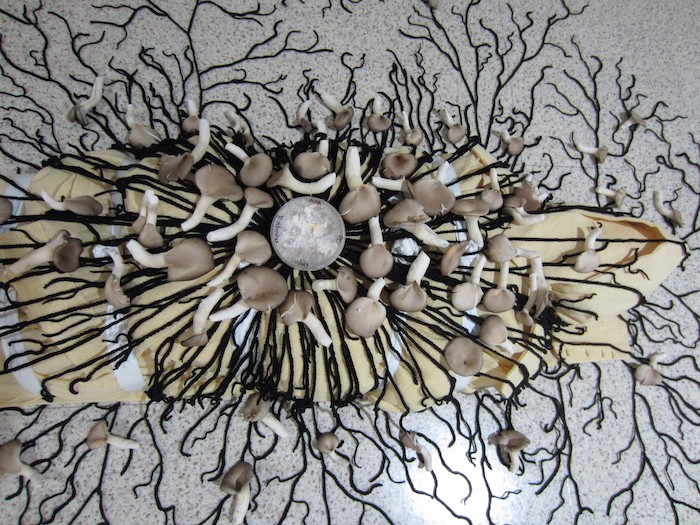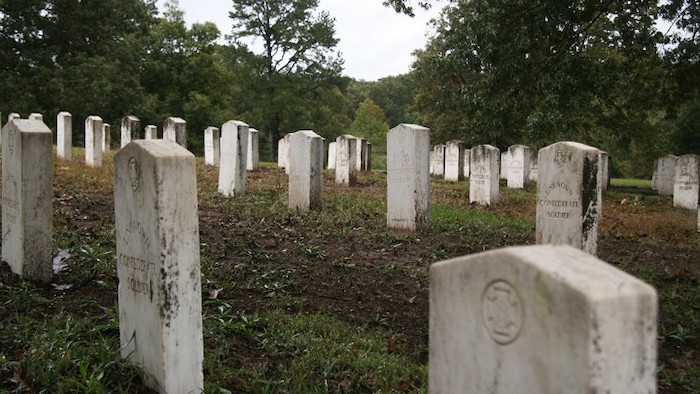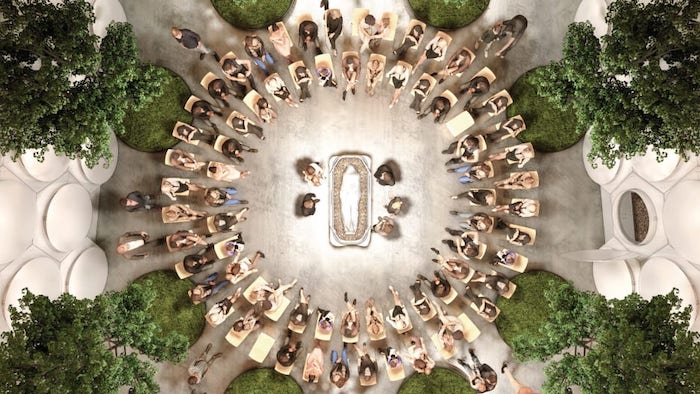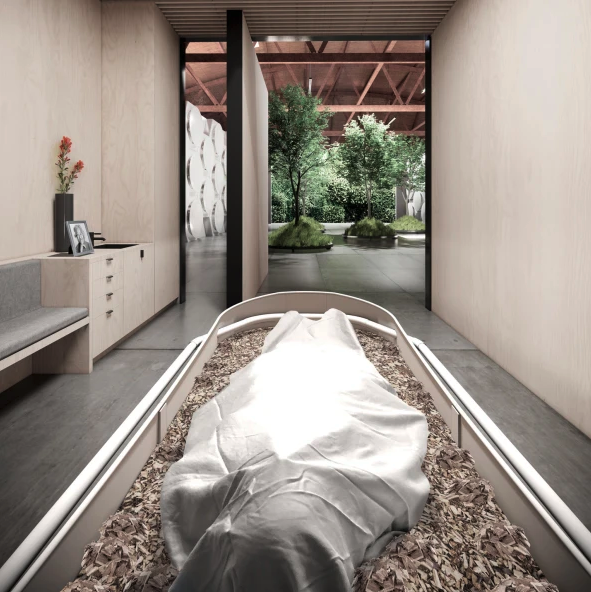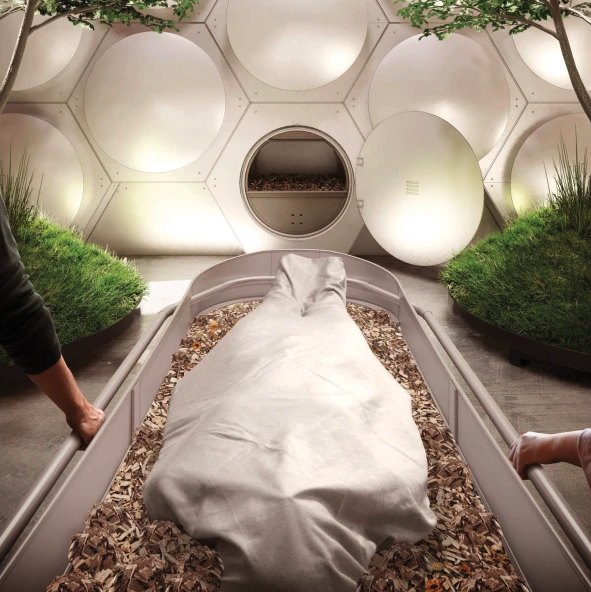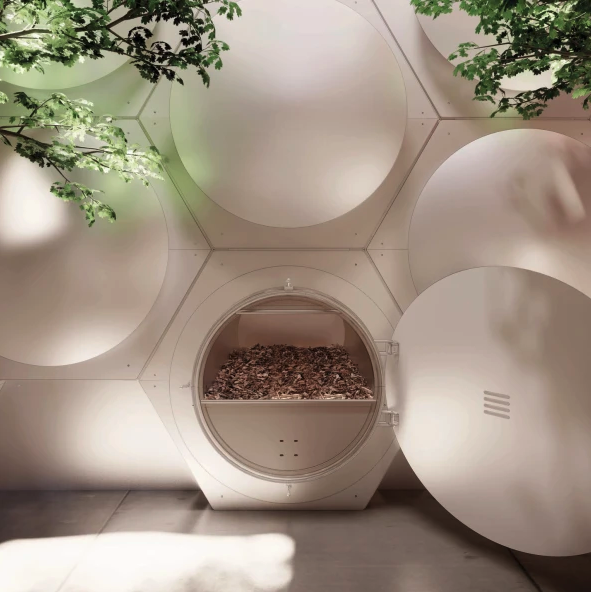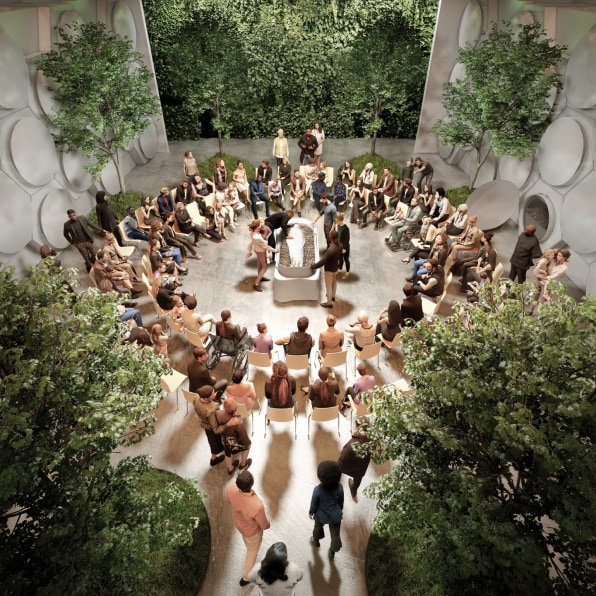This Bay Area start-up wants to change how we think about death

By Austyn Gaffney
Five miles inland from the rocky coast of Mendocino County sits 20 acres of forest. The trees—redwoods, Douglas firs, tan oaks, madrones—line old logging roads. Ferns and rhododendrons soften the forest floor. On a clear day, from a crest in the wooded parcel, there’s the blue snap of ocean.
It’s near this crest that Sandy Gibson, founder and CEO of Better Place Forests—a company whose mission is to conserve land by turning it into natural cemeteries—showed me his gravesite. Trees marked by orange, pink, or blue ribbons were available for burial plots, but Gibson’s redwood, towering above a dry creek bed, was ribbonless, signifying its purchase. Nearby trees with small copper plaques at their base, reminiscent of US Geological Survey markers, served as people’s tombstones.
Gibson has been yoked to death from an early age: When he was 10, his father died of a stroke, and a year later, cancer took his mother. As a child, he remembers leaving their gravesites before they were even filled in with soil, and later visiting a shiny black tombstone along a busy street in Toronto, Canada. With a voice gentle but earnest, like he’s intimately familiar with the octaves needed to discuss death, Gibson explained on this foggy morning in August how he now finds comfort in seeing a ceremony to its end.
“We’ve been burying our dead for 50,000 years in cemeteries,” Gibson told me. “The earliest things we can find are basically tools in caves and burial sites. The idea of a permanent sacred space for the people that you love is something deeply and innately human.”
Better Place Forests takes cremated ashes, which are, essentially, bacteria-free bone dust, and spreads them in forested properties. When mixed with bacteria-rich soil, the nutrients in the ashes break down and feed a tree’s root system. On a bronze table next to the visitor’s center, forest stewards sift cremated remains with soil. Then, they lead a “spreading ceremony,” ushering loved ones into the forest and up to the base of the selected tree. There, the sifted soil is mixed with more dirt. Ashes to ashes, dust to dust, the dead are returned to the earth.
Now 36, Gibson is the epitome of a start-up CEO—gray hairs pepper his temples and his beard. He’s clean-cut but practical—a button-up shirt, slim pants, and walking shoes. For seven years, Gibson and one of his two partners at Better Place Forests, Brad Milne, ran a software company in Toronto. But Gibson was dissatisfied. Software could disappear one day. He latched onto the idea of creating something physically beautiful that might endure a technological collapse. (In the 45 minutes Gibson and I spent touring his Point Arena property, he referred to beauty, on average, once every 60 seconds.)
“I used to think about nothing, about blackness,” Gibson said, turning to face me beside his redwood. “Now there’s certainty. And that certainty is beautiful.”
Depending on traffic, Point Arena lies three to four hours north of San Francisco. A second site, slated to be open for burials in 2020, is two hours south in Santa Cruz. Better Place Forests is purchasing as much land as it can, as fast as it can, with plans to expand into Washington, Oregon, Colorado, and Arizona. Although Gibson claims he started his company in California to be near the redwoods, it probably doesn’t hurt to be close to Silicon Valley. The biggest challenge, though, might be getting investors excited about death.
“It’s a scary topic,” Gibson admitted. “But people love nature. They love protecting nature. You’re changing the discussion from one about death to one about conservation and beauty. That one’s a lot more accessible.”
Along with the promise of closure, Gibson and his team are selling the notion of legacy through conservation. If cemeteries take up space, Gibson wondered how death could do the opposite. How could it give space back? By purchasing a tree, customers invest in the preservation of a natural landscape. Each purchase also triggers an “impact trees” program, which commits to replanting a certain number of trees—between 25 and 400 depending on the price of the purchased tree—in wildfire-affected areas of California.
Before Better Place Forests came to Point Arena, this former logging parcel was full of dense underbrush that made it more susceptible to forest fires. By establishing conservation easements on purchased properties, Better Place Forests promises to pay for the ongoing management of the entrusted land. Furthermore, if the start-up goes under, the land will be protected in perpetuity. But the process is a bit complicated. Negotiations for the easement on the Point Arena property are still incomplete, though as of October approximately 100 spreadings had taken place.
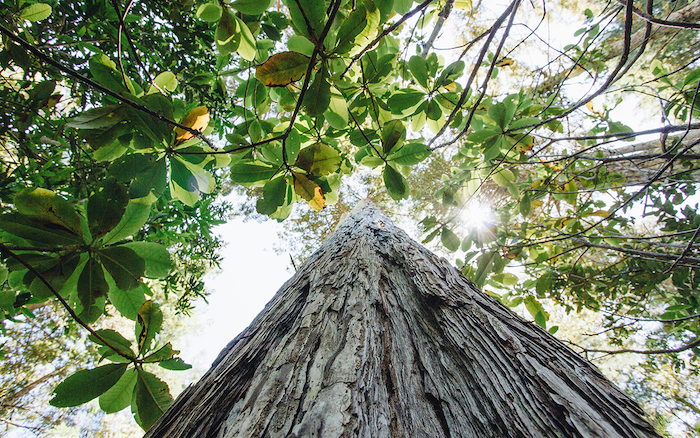
For the past 150 or so years, the United States has developed a far-reaching death industry. Before the Civil War, families mourned and buried their dead at home. But the staggering amount of dead bodies from the war, needing to return home for one final ceremony, led to embalming and undertakers. Business began to boom, introducing more elaborate coffins and making engraved stone markers more common.
The price tag of death spiked, damaging both pocketbooks and the environment. According to Mary Woodsen of Cornell University, in the US alone, conventional burials account for 20 million board feet of wood, 1.6 million tons of reinforced concrete, 17,000 tons of copper and bronze, and 64,500 tons of steel each year. Over 4 million gallons of embalming fluid are used annually, almost one-fifth of which contains formaldehyde, a toxic substance linked to increased cancer risks among funeral-industry workers.
In her 2015 book, Greening Death: Reclaiming Burial Practices and Restoring Our Tie to the Earth, Suzanne Kelly laments the “walled-off city of contaminants” that will flood her own father’s body after he is embalmed, placed in a wooden casket, and then a metal casket, before being encased in a concrete vault inserted into the ground and then buried beneath the dirt. Kelly fears his grave will become a problem, instead of a place of mourning. Mounting awareness of these impacts has led to a growing movement for green burials, which the Green Burial Council defines as “a way of caring for the dead with minimal environmental impact.”
The process of cremation—which accounted for less than 10 percent of US burials in 1980, but today plays a role in over half—isn’t great for the environment either. Along with emitting carbon dioxide and mercury, cremation uses enough natural gas to power a 500-mile car trip, though, according to Kelly, advocates are pushing for renewable forms of energy and crematory filters to limit contaminants. Water cremation, or alkaline hydrolysis, is also on the rise, using a water-based solution, instead of heat, to speed up decomposition. It uses one-fifth the energy of fire cremation and better retains the body’s nutrients.
Today, there are approximately 93 green burial sites across the US. The first cemetery certified by the Green Burial Council was a preserve in South Carolina founded to protect a quarter mile of Ramsey Creek. Opened in 1998, it now encompasses over 60 acres, and over 400 natural burials, both whole body and cremation, have taken place on the site. Management practices on the land are permanently restricted so it remains wild.
Along with better environmental standards, green burials tend to be less expensive than conventional ones. In the past 30 years, funeral costs have risen almost twice as quickly as any other consumer items. According to the National Funeral Directors Association (NFDA), in 2017, funerals with a burial, viewing, and vault cost an average of $8,755. But green cemeteries, like Honey Creek Woodlands in Georgia, advertise natural burial plots for $3,200. For natural burials involving cremation, those costs drop between $1,150 and $2,700, depending on the location.
Though trees in Better Place Forests are hardly cheap. While community trees (in case you’d like your ashes to mingle with those of a bunch of strangers for eternity) start at $950 per spreading; individual trees begin at around $3,000 and can go upwards of $17,000. Each tree includes one to two ceremonial spreadings, and each additional spreading is an additional cost. But if all your relatives agree to be interred beneath the same tree, that spreading fee can be about an eighth of the cost of a conventional burial.
Most natural burial sites, including Better Place Forests, don’t include the cost of cremation, which ranges widely from a few hundred to a few thousand dollars. The number of funerals involving cremation is expected to rise to almost 80 percent of burials by 2040. And although more baby boomers are choosing cremation, they’re not all choosing cemeteries.
It’s a good thing, because we’re running out of space. According to a 2012 study, if all Americans who reach 78 years old (the average life expectancy) chose to be buried in standard plots, by 2042 we’d need 130 square miles of pure grave space, an area about the size of Las Vegas.
The green burial movement subverts the major economic interests of the funeral industry in other ways besides circumventing traditional funeral services. Returning people to the earth in a more natural way doesn’t surround death with sales of land, resources, and facilities. Service Corporation International, the largest multinational funerary business, reported a revenue of over $3 billion in 2018 alone. It’s estimated to comprise at least 15 percent of the death-care industry in North America, operating almost 1,500 funeral service locations and close to 500 cemeteries. Their report to the United States Securities Exchange Commission stated that they were “poised to benefit from the aging of the American population.”
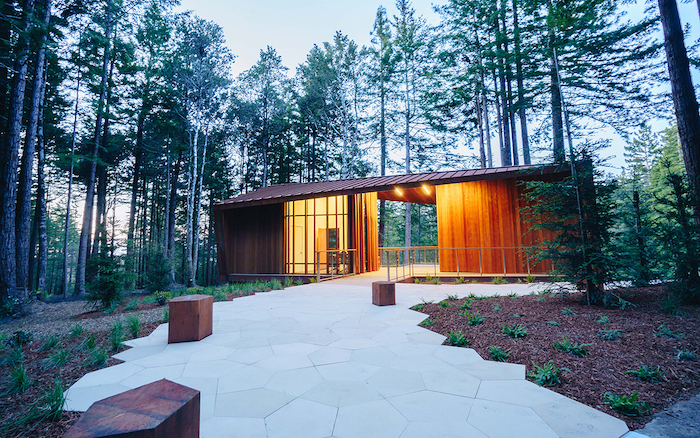
Kathee Pfalmer, a baby boomer from California, had a hard time talking about her eventual passing with her family. She’d brought up various unconventional burial methods with her four children. Would they like mom’s ashes pressed into stones reminiscent of diamonds and made into rings? Or perhaps a nice piece of pottery with her ashes worked into the glaze? Unfortunately, she couldn’t imagine her children saying, “Let’s go pick up mom’s vase.” Then she stumbled across a Facebook ad for Better Place Forests.
When she visited the Point Arena forest in October, she, like Gibson, connected with a redwood tree. Although genetically the same, her tree has two trunks that appear distinct, and the pale stump of a burned tree, left over from a 1906 forest fire, leans against them. Pfalmer says the trio resonated with her because of her eclectic mix of family members, who though not all biologically related, are very loving and supportive of one another. Her decision has shifted the conversation with her children.
“Something about buying this tree and having a place helps me talk to my kids about it,” Pfalmer told me over the phone. “They can imagine my passing without thinking about me dying.”
In a 2017 study by NFDA, over 60 percent of respondents felt it was important to communicate funeral plans, but only 21.4 percent had done so. More than half of all respondents wanted to explore green funerals as a way to reduce their environmental impact. Or perhaps, to become a positive contribution to an environmental web.
“I thought it was a really good way of introducing the finality we all come to,” says Pfalmer, who brought along her 14-year-old granddaughter to pick out her tree. A lifelong gardener, Pfalmer is familiar with the cycle of life and death. She wants the cycle of her life honored in a natural way, and she hopes that for her granddaughter, the experience “might help her feel more at peace with the inevitability of death as part of life.”
Cody Sanders, a Baptist pastor and theologian who specializes in how death care impacts the environment, believes our corpses aren’t dying in a natural way but instead are being withheld from the ecosystem to which they belong. He argues that in death, our corpses can be in tune with the earth’s own cycles of life and continue living through the transformative process of decomposition.
“We’ve done everything we can in the last 150 years or so to deny the earth the life it could receive through our dead bodies,” Sanders writes in a paper for the journal Pastoral Theology.
Sanders suggests that how we treat our dead “mirrors ideologies and theologies that have arisen that suggest humans are not a part of the earth,” and that this “has strong ties to the practices that are contributing to the climate collapse at this point.”
Suzanne Kelly, author of Greening Death, claims sustainable death choices could provide a new tool for engaging in climate anxiety—a more intimate connection to the earth. In her book, she quotes Bob Fertig, a green-friendly funeral director, who says, “The focus on the environmental aspect [of the green burial movement] is wonderful, but I think what sometimes gets lost in that is the potential for closeness with death and the way it makes people feel.”
In other words, green funerals aren’t just good for the environment. In an age of climate crisis, strengthening the bonds between people and the planet can be good for the human psyche too.
*
Weeks after visiting the Point Arena forest, I called my dad and asked him, “Would you like to be buried beneath a tree?”
My father has had a rare form of stomach cancer for over half a decade. I found out after graduating college while lying on the floor of the apartment I was subletting—not because I was awaiting bad news but because it was midsummer in Kentucky and I had no air conditioning. I thought my father had gone in for a minor surgery, but my mom called, saying they’d found tumors. They’re the kind of tumors that can be stalled but not the kind that go away. He has since retired on disability. He tires often and can suffer stomach pains that send him to the emergency room. He’s taken up meditation and spends time in a condo in Ontario to be closer to family. I often hesitate when he brings up his death. I get tongue-tied in the company of mortality, but now, when referencing another living being, like a tree, I found the discussion flowed more easily.
Of course he’d like to be buried beneath a tree, he said. Since childhood, he’s explored thousands of miles of the outdoors. On his first canoe trip, he was in diapers, and he hitchhiked out to the Canadian Rockies the summer he was 16. He still has the steel-frame, faded red backpack he used to traverse Jasper National Park. We don’t stroll too far from home these days, but we often manage to find our way to a riverbank or some nearby woods. On the phone now, he repeated his desire for cremation, and while he liked the tree idea, he balked at the cost. “Why wouldn’t I just donate what I’d spend reserving a tree to a conservation group?” he asked.
The cynic in me wants to critique Gibson’s model: the continued commodification of the natural world, and of burial sites. The idea that a San Francisco–based start-up is finding capital gains in something as tender-hearted as death. But somehow I keep falling short. Sure it’s just a tree. Sure it’s a lot of money for the ritual of saying goodbye. Aside from the small fact that it’s illegal, I could spread my father’s ashes wherever I like. But the idea of being able to visit his remains while also conserving a natural space? It sounds a little like solace.
“People still need a sense of place. You want to know there’s a place for your family to come,” Gibson told me, echoing Kathee Pfalmer’s wishes for her tree. “You want to know there’s a ceremony that will make it easier for your family to grieve.”
In May, months before I met Gibson in Better Place Forest’s tract of trees, I traveled to the gravesite of my great-grandfather in Nova Scotia with my father and my paternal grandmother. The cemetery was camouflaged along a backroad of birch trees and brambles, but my grandmother recognized the turn-off immediately. She’d visited her father here since he died when she was five years old, and she wanted me to pay my respects at his burial site. There was an intimacy in picking flowers to lay on the graves of our relatives, fenced off between two small fields and curtained with trees. There is a sweetness to these spaces.
Death is part of the ongoing web of life that humans are ecologically tied to by virtue of being mammals on this earth. For Sanders, privileging these alive human bodies “allows us to maintain the destructive fiction that all that is lifeless is inert and without significance or desire. The dead body—lifeless as it may be—is not finished revealing to us our roles and responsibilities for care.” The earth still desires something in relation to our body, Sanders writes—its return to the “aliveness” of the ecological world.
There is a natural order to things that ugly interruptions like cancer, addiction, car wrecks, and other tragedies take away from us. Nature reestablishes that order. It reminds us, especially the nonreligious among us, that there is life after life. Those nutrients in my father’s bones, in my bones, could enrich the soil. I imagine worms eating bits of me, and birds eating bits of worms. I imagine the process of my decomposition spiraling out beyond me. And I admit, it brings me comfort.
Complete Article ↪HERE↩!


